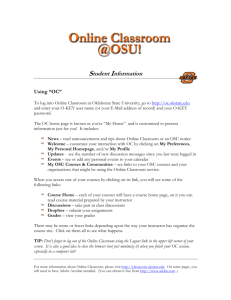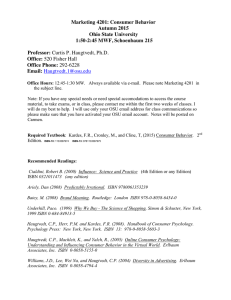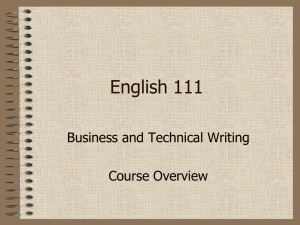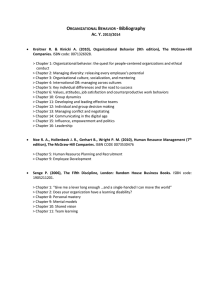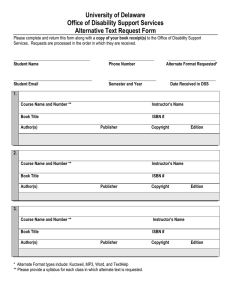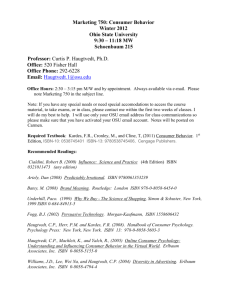Marketing 4201: Consumer Behavior Fall 2012 Ohio State University
advertisement
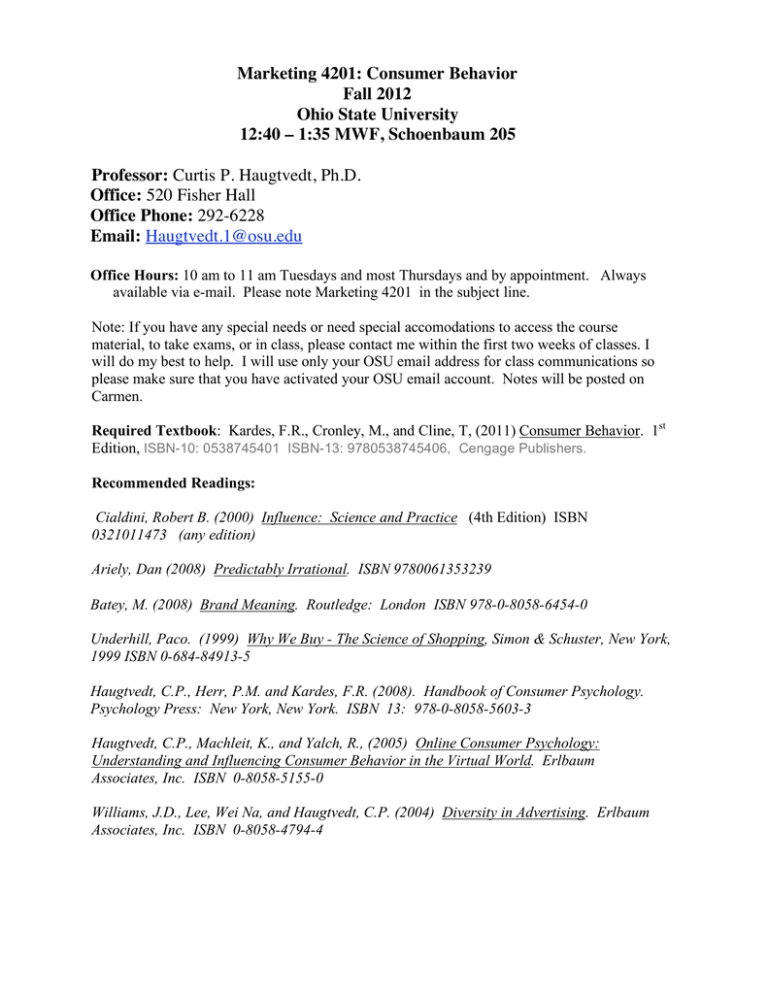
Marketing 4201: Consumer Behavior Fall 2012 Ohio State University 12:40 – 1:35 MWF, Schoenbaum 205 Professor: Curtis P. Haugtvedt, Ph.D. Office: 520 Fisher Hall Office Phone: 292-6228 Email: Haugtvedt.1@osu.edu Office Hours: 10 am to 11 am Tuesdays and most Thursdays and by appointment. Always available via e-mail. Please note Marketing 4201 in the subject line. Note: If you have any special needs or need special accomodations to access the course material, to take exams, or in class, please contact me within the first two weeks of classes. I will do my best to help. I will use only your OSU email address for class communications so please make sure that you have activated your OSU email account. Notes will be posted on Carmen. Required Textbook: Kardes, F.R., Cronley, M., and Cline, T, (2011) Consumer Behavior. 1st Edition, ISBN-10: 0538745401 ISBN-13: 9780538745406, Cengage Publishers. Recommended Readings: Cialdini, Robert B. (2000) Influence: Science and Practice (4th Edition) ISBN 0321011473 (any edition) Ariely, Dan (2008) Predictably Irrational. ISBN 9780061353239 Batey, M. (2008) Brand Meaning. Routledge: London ISBN 978-0-8058-6454-0 Underhill, Paco. (1999) Why We Buy - The Science of Shopping, Simon & Schuster, New York, 1999 ISBN 0-684-84913-5 Haugtvedt, C.P., Herr, P.M. and Kardes, F.R. (2008). Handbook of Consumer Psychology. Psychology Press: New York, New York. ISBN 13: 978-0-8058-5603-3 Haugtvedt, C.P., Machleit, K., and Yalch, R., (2005) Online Consumer Psychology: Understanding and Influencing Consumer Behavior in the Virtual World. Erlbaum Associates, Inc. ISBN 0-8058-5155-0 Williams, J.D., Lee, Wei Na, and Haugtvedt, C.P. (2004) Diversity in Advertising. Erlbaum Associates, Inc. ISBN 0-8058-4794-4 Course Description and Objectives: This course involves a review and analysis of theories and research methods from social and behavioral sciences (e.g., psychology, sociology, anthropology, economics, etc.) as they relate to understanding and predicting the behavior of the various players in the marketplace. Students will learn how to interpret, evaluate, and apply behavioral research principles to marketing problems. After taking this course, you will understand consumer behavior from a variety of perspectives; develop the ability to apply the broad principles underlying human behavior in general and consumer behaivor in particular in a variety of contexts and situations; better appreciate and understand the multiple roles played by marketing research, marketing strategy, and basic research on intra- and interpersonal processes in contemporary marketing practice; develop and enhance your analytical and presentation skills. Preparation: Students should be prepared to discuss and answer questions about text, lecture and other assigned reading material. Active OSU E-mail Account Required (please have your OSU email forwarded to other accounts if you do not use OSU email). Class material and web assignments will be available via Carmen. Additional cases may be assigned. COURSE ORGANIZATION Classes: Lecture/discussion format. Lectures and discussions are intended to reinforce text and other readings. Exam: Two Exams. Multiple Choice, Short Answer, Concept Identification. Students are responsible for all reading material even if not explicitly discussed in class. Feel free to ask about any textbook material at any time. Papers/Presentation: Each student can choose one of the three following options. Inform the instructor of your choice by October 15th via email. 1. A research paper. Working with the professor, the student identifies an area of in-depth study. The paper will consist of a review of relevant academic and popular press materials on the topic. The paper will include suggestions for additional research as well as the managerial implications of the research and theory on the topic. Approximately 20 page paper (including references, APA Style). 7 minute class presentation. 2. An in-depth ethnographic analysis of consumer behavior. A systematic qualitative assessment of consumer behavior in a specific setting (phyiscal or virtual). Approximately 20 page paper (APA Style). 7 minute class presentation. 3. Analysis of Cross Cultural Consumer Behavior and marketing communications Focus on advertising, product promotions, etc as they vary (or should vary) across cultures. Class presentation should include example marketing stimuli and links to theory and research from the textbook and/or other disciplines. 7 minute class presentation. Approximately 20 page paper (APA Style). All papers should use American Psychological Association format for references and in text cites. Participation: In-class and online participation are very important in this class. In-class and online participation are each worth 50 points (100 total points for participation). 50 points: Consistent leader in the classroom. Always prepared and initiates class discussion. Comments are focused and integrative (linking materials to other courses, work experiences, current events, etc..). Provides web links and commentary on topics relevant to the course. Integrates materials and discussions with other courses, experiences. Starts new discussion topics and thoughtfully comments on discussions started by other students. Provides supportive evidence for point of view. 40 points: Quality participation. Responds to instructor comments and questions. Provides examples. Provides links to relevant web pages with some personal commentary. Responds to postings of other students and occasionally starts new discussions. 30 points: Occasional contributions to class discussions. Brings in some new material and some new ideas. Rarely starts discussions. Simply agrees or disagrees with the postings of others. Provides little supportive evidence 20 points: Answers questions from the instructor. Sometimes responds to other students. Attends class regularly. Rarely posts to the bulletin board. 10 points: Attends class regularly but does not participate. Less than 3 posts to the bulletin board. Grading: Exams worth 150 points each. Research paper/presenation worth 150 points. Participation worth 100 points. Total Possible Points: 550. Letter grades will be assigned on the basis of the following percentage of total points: 93-100% = A, 90-92% = A-, 87-89% =B+, 83-86%=B, 80-82%=B-, 77-79%=C+, 73-76%=C, 70-72%=C-, 67-69%=D+, 63-66% = D, 62% or below = Failing. Academic Misconduct: Students enrolled in courses at the Ohio State University are expected to adhere to the highest standards of academic conduct. The instructor and his/her assistants will be alert to any kind of inappropriate academic conduct in this course. Suspicion of academic misconduct will be handled by official rules and policies of Ohio State University. Penalties for cheating or plagiarism may range from a failing grade on an exam or assignment, a failing grade in the course, or expulsion from the university. The Fisher College of Business strongly enforces University attendance policies. As per University rule 3335-8-33, any student may be disenrolled from a course for failure to attend by the first Friday of the term, or by the 3rd instructional day of the term, or by the second class meeting, whichever occurs first. Course Schedule Week 1 (August 22nd) Course and student introductions Week 2 (August 27th) Consumer Behavior Research Methods Chapter 1, 2 Week 3 (Sept. 4th) Consumer Behavior Research Methods cont’d Week 4 (Sept. 10th) Consumer Perception and Attitude Change Chapter 3, 4 Week 5 (Sept. 17th) Motivation and Emotion, Learning and Memory Chapters 5 and 6 Week 6 (Sept. 24th) Automatic Information Processing, Self Concept Chapters 7 and 8 Week 7 (October 1st) Exam 1 (Monday, October 1st) Consumer Decision Making Chapter 9 and 10 Week 9 (October 8th) Behavioral Decision Theory Chapter 11 Week 10 (October 15th Culture and Values Chapter 12 Week 11 (October 22nd) Social Influence and Behavioral Compliance Chapter 13 Social Media and E-Commerce Chapter 14 and 15 Week 12 (October 29th) Branding Strategy and Consumer Behavior Chapter 16 Consumer Behavior and Public Policy Week 13 (Nov 5th) Exam II (Monday, Nov. 5th) Student Paper Presentations begin Week 14 (Nov 12th) Student Paper presentations Week 15 (Nov 19th Student Paper presentations (no class Nov 23rd) Week 16 (Nov 26th) Student Paper Presentations Week 17 (December 3) Work on Research Papers Final Paper Due by 5 pm, Friday, December 7th)
